It’s huckleberry season in the Pacific Northwest. The juicy berries with a sweet and tart flavor can be found from July until September or early October, depending on how high into the mountains you go.
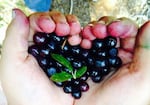
In this undated, supplied image, Kaiwin Clements, a member of the Confederated Tribes of the Warm Springs, holds freshly picked huckleberries in the shape of a heart.
Courtesy of Merle Kirk via Northwest Public Broadcasting
Huckleberries thrive in the Rocky Mountains, and are often found in the forests of Oregon, Idaho, Washington state and Montana.
As more people have moved to the region in recent years, these delicious and delicate berries are in higher demand. That’s causing problems.
Higher traffic in popular huckleberry picking spots and people taking the bushes out by the roots are among the issues being reported by U.S. Forest Service field staff.
“For one thing, it’s illegal to damage or remove huckleberry bushes. But on the practical side, huckleberries are easily out-competed by other plants. So if you remove a bush, it’s pretty likely that it’s never going to grow back in that exact spot,” said Neil Shurtz, a public affairs specialist with the Idaho Panhandle National Forests.
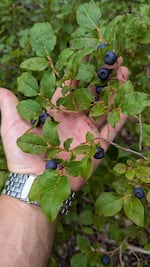
When ripe, huckleberries should roll gently from the stem into your palm. This is an undated supplied image.
Courtesy of Brian Hanson via Northwest Public Broadcasting
Shurtz is encouraging first-time huckleberry pickers to go out and explore to find new locations to lessen the impact on the environment.
“Get a motor vehicle, use a map for the forest that’s available online and at all the ranger stations, get to know the road network, go out there, find your own secret spots,” he said.
Brian Hanson has been picking huckleberries with his family in north Idaho for more than 30 years. The family has had a cabin on Priest Lake for generations.
“The best way to pick the berries is to pluck straight up by pinching the stem,” Hanson said. “If they don’t pop off, they’re not ripe.”
Clint Emerson is a botanist for the U.S. Forest Service who works in the forests of Oregon and Washington. He said you’ll often find huckleberries in mountain meadows that get a lot of snowpack in the winter.
“These openings and these meadows gather, you know, feet of snow. And that’s really important to the species, and it has a connection there with climate change,” Emerson said.
Drought conditions and wildfires are also threatening huckleberry habitat in certain areas, he said.
Huckleberry picking best practices
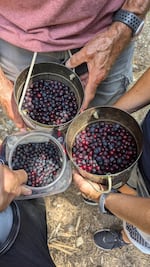
In this undated supplied image, the Hanson family shows off the huckleberries they picked near Pack River on the Idaho Panhandle’s Rocky Mountains.
Courtesy of Holly Hanson via Northwest Public Broadcasting
To lessen the impact on the environment while gathering huckleberries, leave some fruit on the bushes. That way, wildlife gets a snack, and the plant has a chance to start new bushes, said Emerson.
Harvest with your hands, rather than using mechanical tools like rakes. Those tools can damage the huckleberry plants, leaving them susceptible to disease, Emerson said.
Call your local ranger station to see if a permit for gathering huckleberries is required in your area. Idaho does not require a personal use permit for picking the berries, but Washington and Oregon do.
If people are pulling out bushes or damaging plants, rather than confronting them, report the details to your local ranger station.
Safety first in the forest
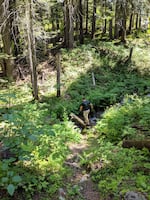
Look for huckleberries in mountain meadows and near sources of water like creeks. A Northwest hiker makes his way through the Nez Perce-Clearwater National Forest searching for huckleberries in this undated image.
Lauren Paterson / Northwest Public Broadcasting
If you’re venturing out into the forest where cell phone service is limited or nonexistent, always let people know where you’re going and when you plan to be back, Emerson said.
Higher elevation spots where huckleberries can be found, like Mount Hood, can take hours to get to, he said.
Carry bear spray if you’re picking out in the forest. Keep dogs on a leash or leave them at home so they don’t agitate the bears, Shurtz said. Both black bears and grizzly bears live in the forests of the Northwest.
Make sure to pack extra water, and ensure you have the right gear for your adventure.
The Idaho Panhandle National Forests have maps available online, and maps for Region 6 (Washington and Oregon) also are online at usda.gov.
Respecting Indigenous cultures
Huckleberries are also a culturally significant food for many Northwest tribes, celebrated as a first food.

Qumsali Red Elk Wainanwit and her aunty, Acosia Red Elk, on Mount Hood picking huckleberries in this undated supplied image.
Courtesy of Wenix Red Elk via Northwest Public Broadcasting
The berries are packed with antioxidants, vitamin C and vitamin A. They are a sacred food to many Northwest tribes, who also used them medicinally for hundreds of years.
Althea Huesties-Wolf works in the First Foods Policy Program in the Department of Natural Resources for the Confederated Tribes of the Umatilla Indian Reservation (CTUIR). The tribe is working on a first foods policy with goals around huckleberry management and harvesting, she said.
“It’s basically a blueprint for why we manage the way we do,” Huesties-Wolf said. “We want to be able to take it and give it to a state or federal agency so they can incorporate our ways of thinking into their plans.”
A recent study showed climate change could cause huckleberries to ripen sooner over the next 75 years. Now, the tribe is collecting their own local data to figure out a forestry management plan to preserve huckleberries for generations to come.
“We want to make sure we have the tools in the future to make management decisions that will continue to keep the huckleberry resilient,” said Amanda Lowe, a soil conservationist for the Department of Natural Resources at CTUIR.
For hundreds of years, the tribes managed wild huckleberries with controlled burns.
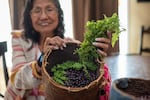
Alvina Burke-Huesties, a member of the Confederated Tribes of the Umatilla Indian Reservation, uncovers a basketful of recently harvested huckleberries at the home of her daughter, Althea Huesties-Wolf, last summer near Mission, Oregon. The family collects and preserves this important traditional food in baskets that are passed down through generations.
Annie Warren / Northwest Public Broadcasting
“The cultural burns are very significant because they would be able to get down the weeds and grass, and push back the wild rose and willows and other natural resources encroaching on the huckleberries,” said Winex Red Elk, a public education outreach specialist for the CTUIR Department of Natural Resources.
The U.S. Forest Service is setting up agreements with multiple tribes to collect and store huckleberry seeds for genetic conservation, Emerson said. There are plans in the works to work with Northwest tribes and use Indigenous knowledge to repopulate huckleberries in areas that have been damaged by severe wildfires.
Agreements to work on restoring damaged habitat and help mountain meadow huckleberries flourish are already in place with the Tulalip Tribes and the Cow Creek Band of Umpqua Tribe of Indians.

Althea Huesties-Wolf and her daughters Stella, center, and Manaia wash huckleberries and chokecherries in preparation for canning at their home on the Confederated Tribes of the Umatilla Indian Reservation near Mission, Oregon, last summer. These sacred first foods are considered “sisters” and are eaten at feasts and ceremonies throughout the year.
Annie Warren / Northwest Public Broadcasting
As the tribes and the U.S. Forest Service work together to help restore and preserve the beloved berry, there are ways to be good stewards of the wild lands.
“It’s pretty disheartening to see all the raking (of huckleberries) going on,” said Merle Kirk, an education outreach assistant for the CTUIR. “It hurts all the nations, and it’s disrespectful to the berry itself.”
Raking all the berries off at the same time takes even the unripe berries off the plant, leaving none for the animals of the forest and preventing the huckleberry bush from being able to reproduce, Red Elk said.
As an educator, Kirk works with young children, showing them how to harvest natural resources responsibly.
“They have their first little berries, and they’re so honored to gather for the community and their family,” Kirk said.
Every summer, tribes across the Northwest pick berries on their ancestral lands and hold huckleberry feasts to celebrate the forest fruit.
It’s important for all of us to be respectful when we go out into the mountains, Kirk said.
“We always have to be mindful, and prayerful, respectful of everything around us, the land, the berries, everything all works together,” she said. “I’m thankful to all partners that are willing to help them continue to grow in a healthy way.”